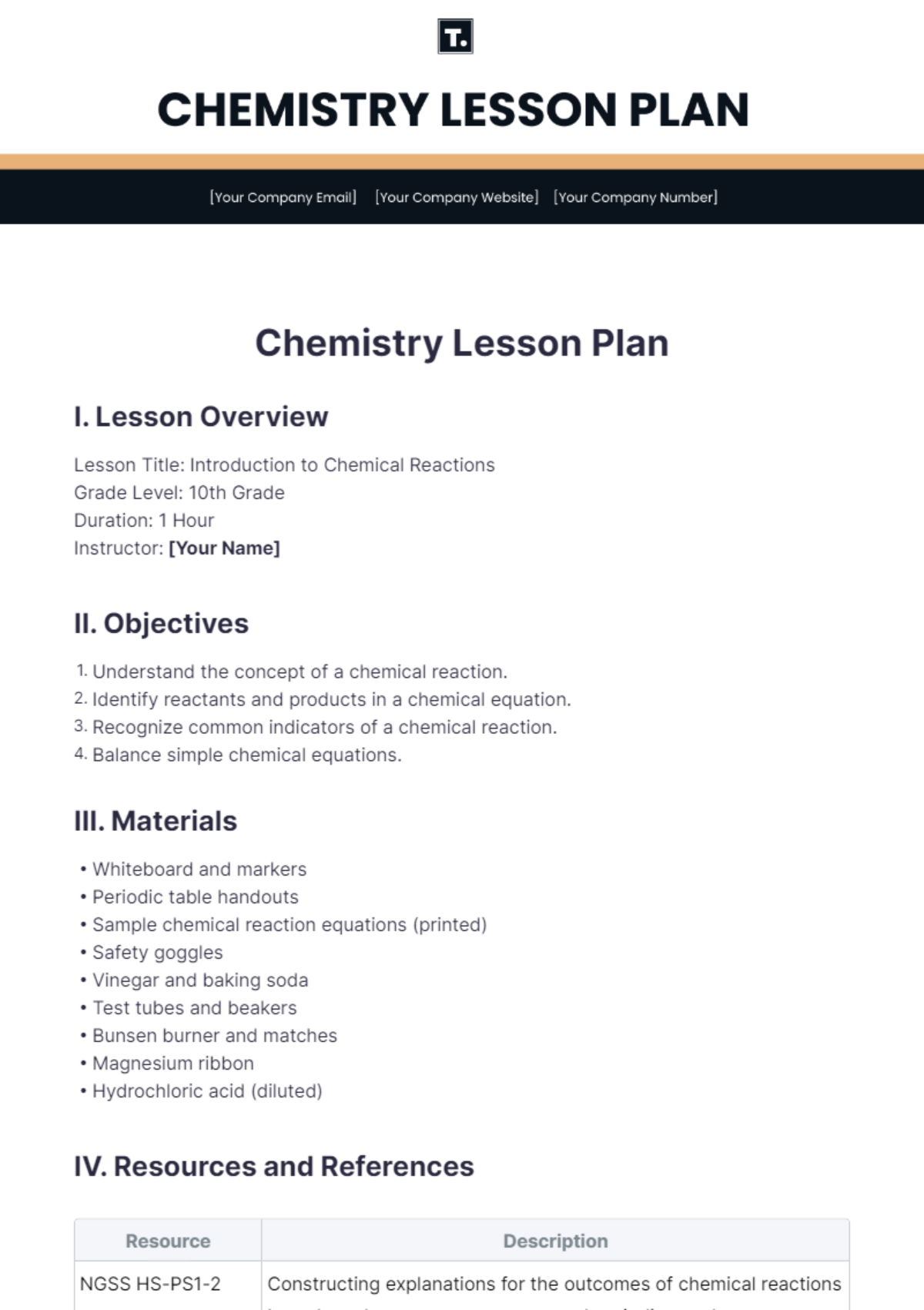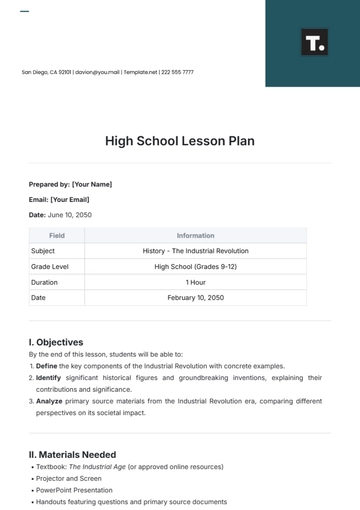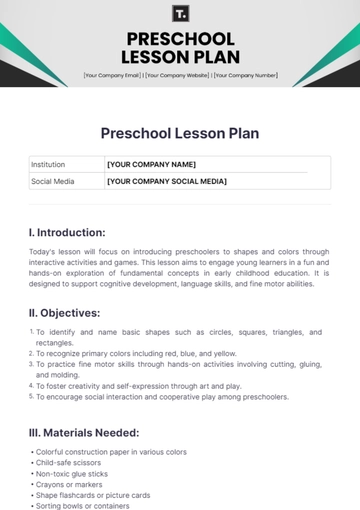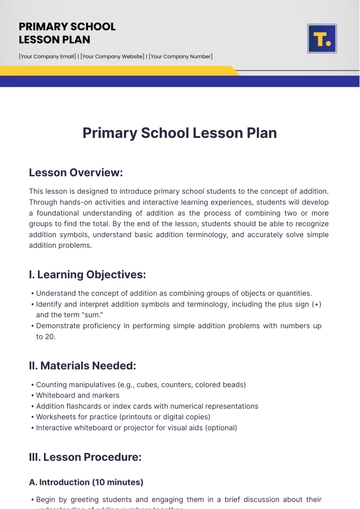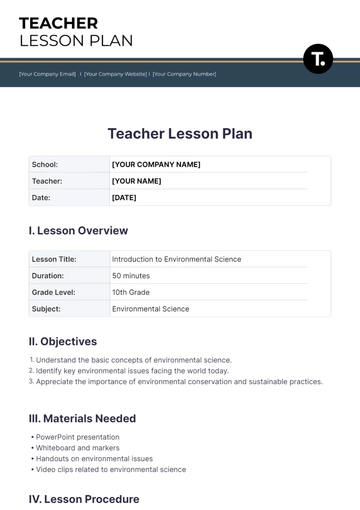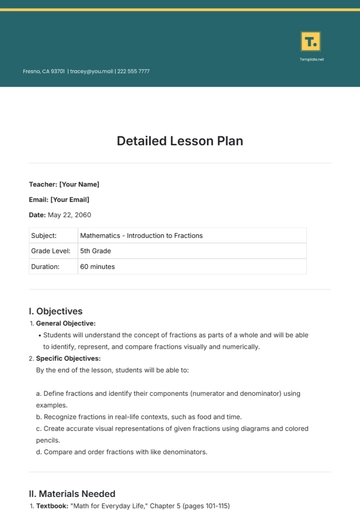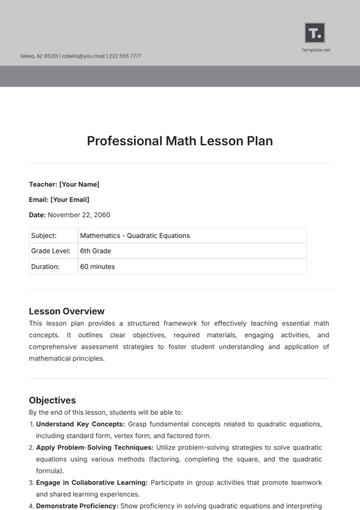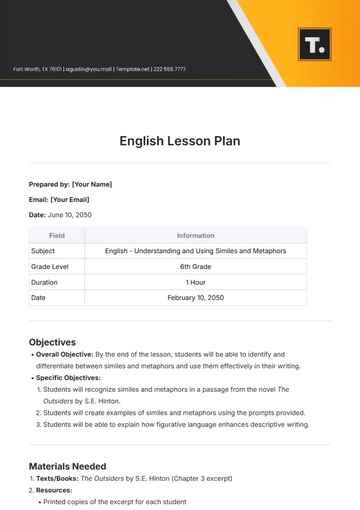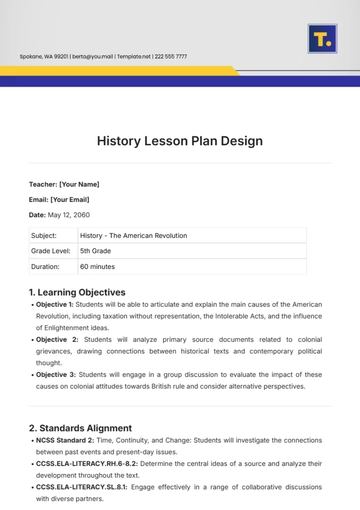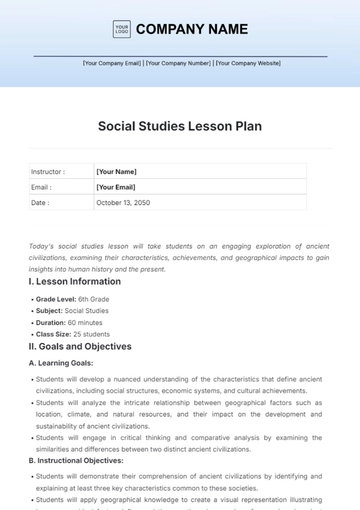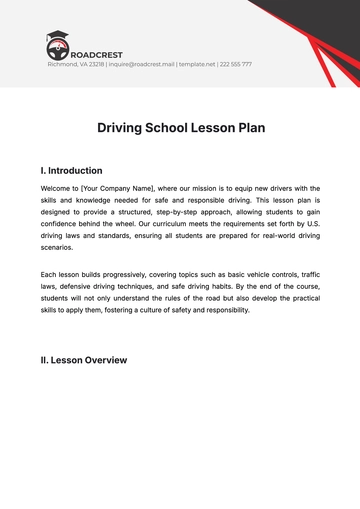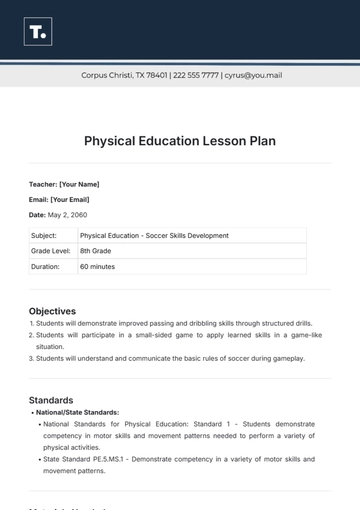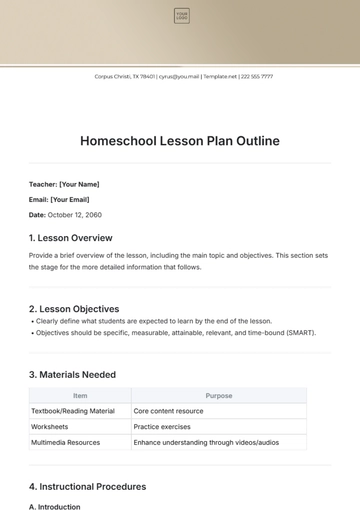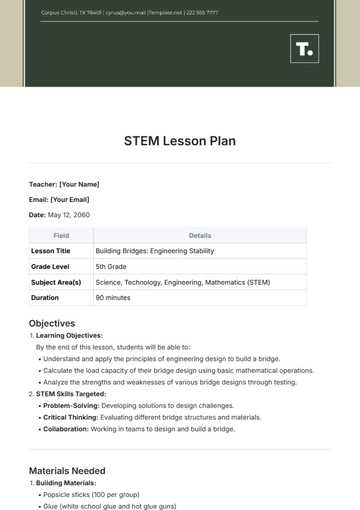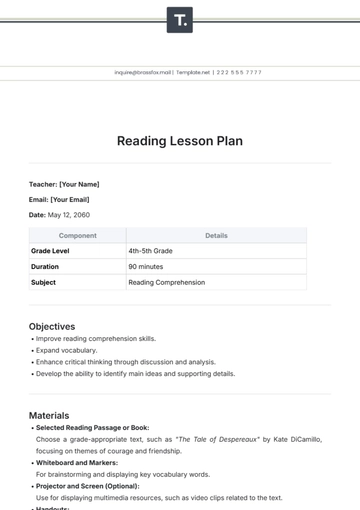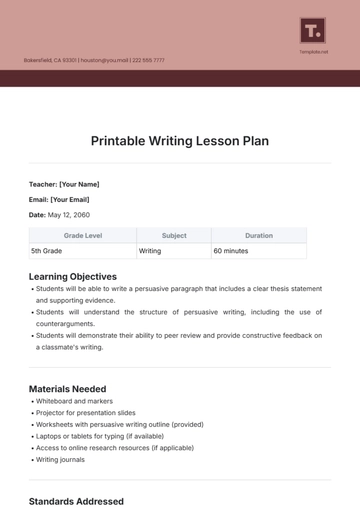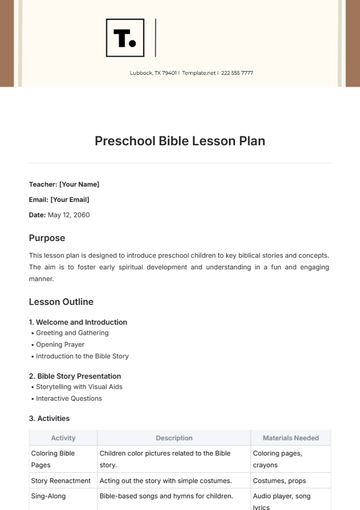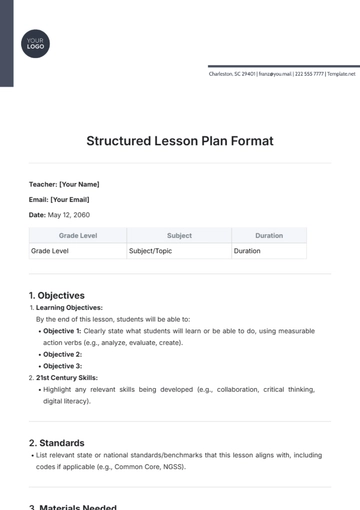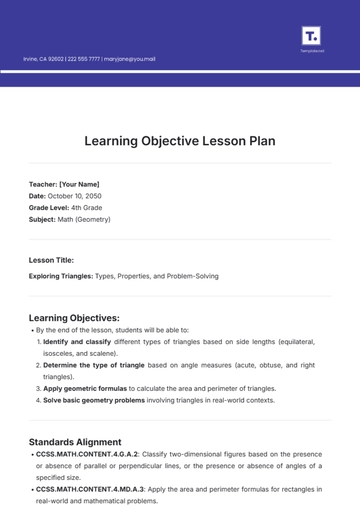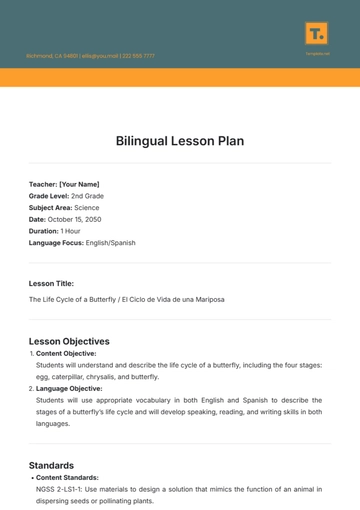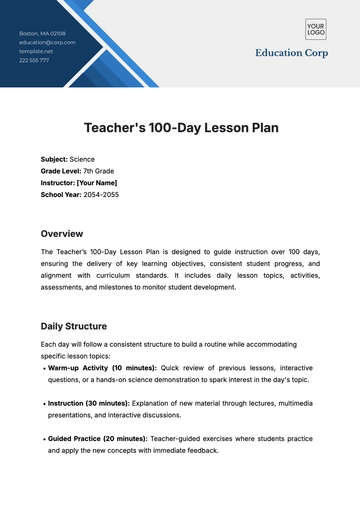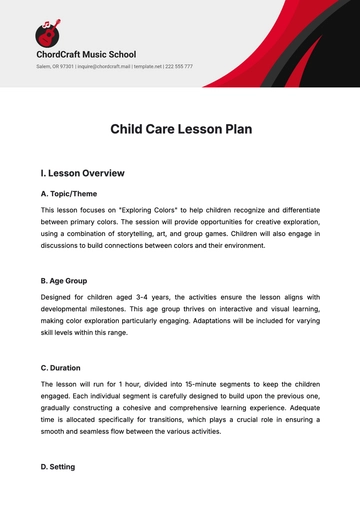Chemistry Lesson Plan
I. Lesson Overview
Lesson Title: Introduction to Chemical Reactions
Grade Level: 10th Grade
Duration: 1 Hour
Instructor: [Your Name]
II. Objectives
Understand the concept of a chemical reaction.
Identify reactants and products in a chemical equation.
Recognize common indicators of a chemical reaction.
Balance simple chemical equations.
III. Materials
Whiteboard and markers
Periodic table handouts
Sample chemical reaction equations (printed)
Safety goggles
Vinegar and baking soda
Test tubes and beakers
Bunsen burner and matches
Magnesium ribbon
Hydrochloric acid (diluted)
IV. Resources and References
Resource | Description |
|---|
NGSS HS-PS1-2 | Constructing explanations for the outcomes of chemical reactions based on electron arrangements and periodic trends. |
Digital Periodic Table Handouts | Digital handouts providing information about elements including atomic number, mass, and electron configuration. |
Virtual Reality (VR) Simulation Software | Immersive software offering virtual lab experiences for students to explore chemical reactions and concepts. |
Digital Worksheets and Interactive Tools | Interactive resources for practicing skills like balancing equations, calculating molar masses, and solving stoichiometry problems |
V. Chemistry Lesson Plan: 15-Week Overview
Weeks 1-5
Week | Topics Covered | Activities and Assessments |
|---|
1 | Introduction to Chemistry | Classroom orientation, safety rules, introduction to the periodic table, basic atomic structure |
2 | Chemical Reactions and Equations | Understanding reactants and products, indicators of chemical reactions, simple reaction demonstrations |
3 | Balancing Chemical Equations | Practice balancing equations, in-class worksheet activities, digital simulation exercises |
4 | Types of Chemical Reactions | Classification of reactions (synthesis, decomposition, single replacement, double replacement, combustion) |
5 | Energy in Chemical Reactions | Endothermic vs. exothermic reactions, energy diagrams, lab experiments to observe energy changes |
Weeks 6-10
Week | Topics Covered | Activities and Assessments |
|---|
6 | The Mole Concept | Avogadro's number, molar mass calculations, converting between moles, mass, and particles |
7 | Stoichiometry | Mole-to-mole ratios, mass-to-mass calculations, limiting reactants, percent yield |
8 | Solutions and Concentrations | Solubility, concentration units (molarity, molality), preparing solutions, dilutions |
9 | Acids and Bases | Properties of acids and bases, pH scale, calculating pH, neutralization reactions |
10 | Chemical Equilibrium | Dynamic equilibrium, Le Chatelier’s principle, equilibrium constant (Kc), factors affecting equilibrium |
Weeks 11-15
Week | Topics Covered | Activities and Assessments |
|---|
11 | Thermochemistry | Heat transfer, specific heat, calorimetry, enthalpy changes |
12 | Kinetics | Reaction rates, collision theory, factors affecting reaction rates, catalysts |
13 | Electrochemistry | Redox reactions, galvanic cells, standard reduction potentials, electrolysis |
14 | Organic Chemistry Basics | Introduction to organic compounds, hydrocarbons, functional groups, basic organic reactions |
15 | Review and Final Assessment | Comprehensive review of all topics, final exam, student presentations, feedback and reflection activities |
VI. Assessment
The assessment strategy for this lesson includes both formative and summative components to gauge student understanding and progress effectively.
A. Formative Assessment
Throughout the lesson, we will monitor student participation and engagement during the guided practice and lab activities. Using VR feedback tools, we can track how well students are following along with the balancing equations and their interactions in the virtual lab environment. This real-time feedback allows for immediate intervention and support where needed, ensuring that students are on the right track and addressing any misconceptions promptly.
B. Summative Assessment
The digital homework assignment will serve as the summative assessment for this lesson. Students will be evaluated on their ability to balance chemical equations accurately. This assessment will not only test their understanding of the lesson content but also their ability to apply the skills learned in a practical context. The homework will be designed to reflect varying levels of difficulty to challenge advanced students while providing adequate practice for those who may struggle with the concepts. Additionally, we will include a mix of multiple-choice questions and open-ended problems to assess both conceptual understanding and problem-solving abilities.
VII. Conclusion
Understanding chemistry is crucial not only for academic success but also for its real-world applications in fields such as medicine, engineering, environmental science, and technology. By mastering these concepts, students are better equipped to pursue further studies in science and to make informed decisions in their daily lives regarding health, safety, and the environment.
This course aims to provide a solid foundation in chemistry, fostering curiosity and a deeper appreciation for the scientific principles that shape our world.
Plan Templates @ Template.net
